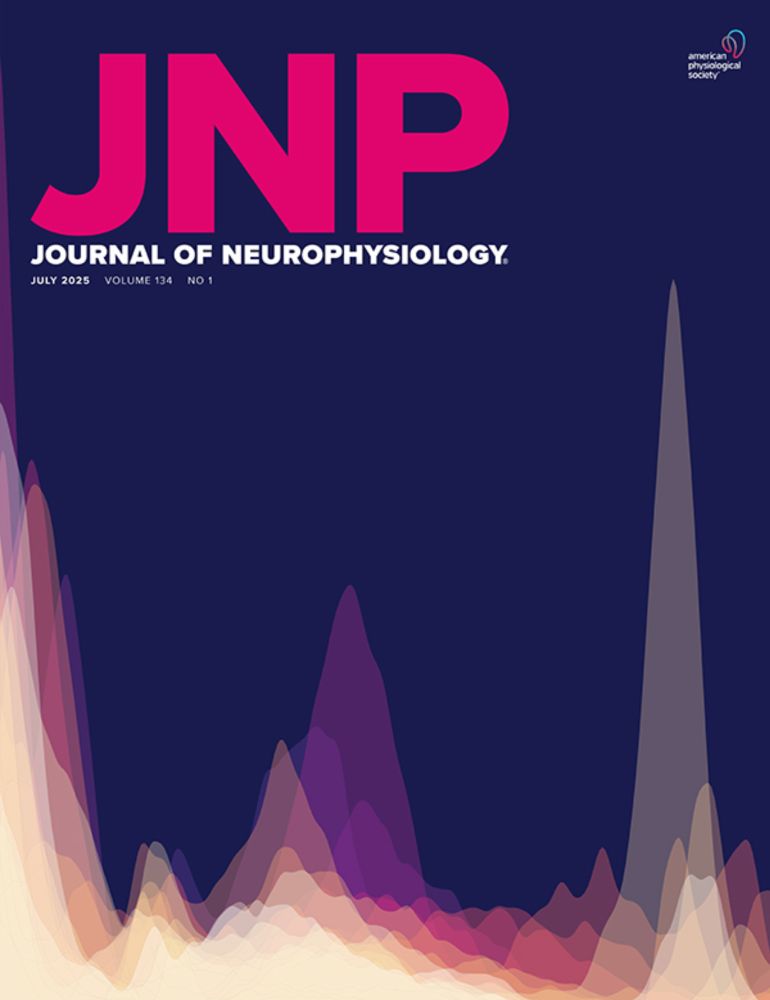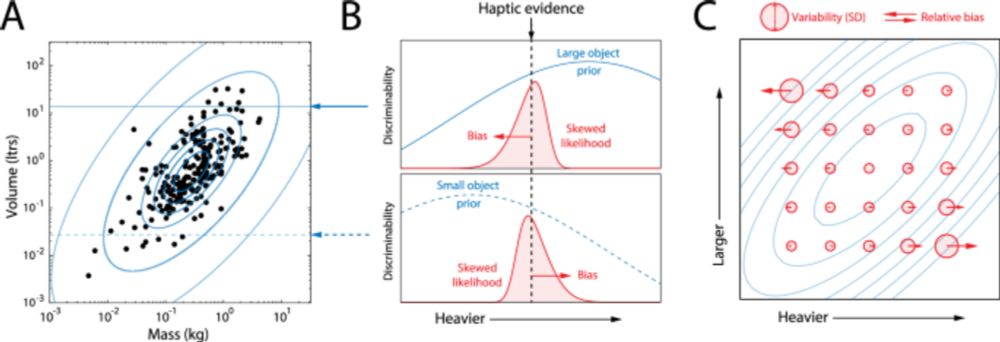
New work on sensory prediction resolves some long-standing puzzles about attenuation of self-touch journals.physiology.org/doi/full/10....
01.08.2025 12:52 — 👍 5 🔁 2 💬 0 📌 1@bayslab.org.bsky.social
Computational cognitive scientist, Professor at University of Cambridge.

New work on sensory prediction resolves some long-standing puzzles about attenuation of self-touch journals.physiology.org/doi/full/10....
01.08.2025 12:52 — 👍 5 🔁 2 💬 0 📌 1
Now out in Comms Psych: the "anti-Bayesian" size-weight illusion is a consequence of the brain focusing resources on encoding typical combinations of size and weight (i.e. "efficient coding"). Explains the material-weight illusion too www.nature.com/articles/s44...
29.01.2025 15:03 — 👍 7 🔁 2 💬 0 📌 1We have an opening for a postdoc to work on a collaborative project with Máté Lengyel (UCambridge Engineering) combining machine learning methods with human experiments on visual perception and memory www.jobs.cam.ac.uk/job/49299/
21.11.2024 17:19 — 👍 1 🔁 1 💬 0 📌 0Out now in NHB (finally!), a review of visual working memory from a computational perspective, with @weijima01 @timothyfbrady and Sebastian Schneegans.
11.06.2024 14:27 — 👍 0 🔁 0 💬 0 📌 0Nice commentary from @salinas_urgent and @mangosheikh_B on our new eLife paper
14.05.2024 13:54 — 👍 0 🔁 0 💬 0 📌 0The size-weight illusion is a by-product of efficient sensory coding adapted to the combinations of volume and mass found in everyday objects. New preprint
12.02.2024 10:05 — 👍 0 🔁 0 💬 0 📌 0We measured how effectively observers can reallocate working memory resources to new visual items when old ones become obsolete - people are surprisingly good at it! New paper with @ivntmc @dataforyounz @DAagtenMurphy
13.01.2023 14:11 — 👍 0 🔁 0 💬 0 📌 0A critique of the psychological similarity account of working memory errors: work with @ivntmc now out in JEP:LMC
10.01.2023 13:25 — 👍 0 🔁 0 💬 0 📌 0New work with Jess McMaster & others: we show swap errors (item confusions) in cued recall are not a strategic response to forgotten items, but instead occur at exactly the rate predicted by variability in recall of the cue features
04.07.2022 10:30 — 👍 0 🔁 0 💬 0 📌 0New in Psych Review with Sebastian Schneegans & Jess McMaster: comparing the roles of time and space in binding features in working memory
17.02.2022 12:41 — 👍 0 🔁 0 💬 0 📌 0We have an opening for a post-doc (or potentially a talented graduate RA) to research computational mechanisms of visual perception/memory using online and offline experiments - note deadline 11 Aug
28.07.2021 09:48 — 👍 0 🔁 0 💬 0 📌 0Views of an object before and after a saccade may be combined even if you are aware the object has changed - new with Garry Kong, @DAagtenMurphy and Jess McMaster.
21.07.2021 10:08 — 👍 0 🔁 0 💬 0 📌 0New in JOV: the ability to combine visual evidence across gaze fixations depends on a limited but flexible memory resource
28.05.2021 10:36 — 👍 0 🔁 0 💬 0 📌 0New paper on the consequences of stroke for recall precision and binding in visual WM, a collaboration with Roy Kessels and colleagues at the Donders (@DondersInst)
05.02.2021 09:10 — 👍 0 🔁 0 💬 0 📌 0Our new Analogue Report Toolbox can be downloaded at . It implements in MATLAB a range of methods we use in the Bays lab for analyzing and modelling behavioural responses on VWM recall tasks, including...
29.09.2020 13:53 — 👍 0 🔁 0 💬 0 📌 0Our new PNAS paper reveals how the main competing models of working memory limits can all be interpreted in terms of sampling. A number of surprises, including that item limits don't require discrete representations.
20.08.2020 15:25 — 👍 0 🔁 0 💬 0 📌 0New with @robthedatafiend in Psych Review: for every visual feature dimension there is a consistent upper bound on the "s.d." you can obtain by fitting errors with a normal+uniform mixture...and it just might be telling us something about neural tuning!
01.04.2020 08:24 — 👍 0 🔁 0 💬 0 📌 0"Stochastic sampling provides a unifying account of working memory limits" - our new preprint:
18.09.2019 19:13 — 👍 0 🔁 0 💬 0 📌 0A short note on BioRxiv on the relationship between the psychophysical scaling account of working memory by @timothyfbrady @markSchurgin and population coding models of the same:
12.07.2019 09:59 — 👍 0 🔁 0 💬 0 📌 0Asymmetric competition in visual working memory: storing orientations doesn't affect memory for facial expressions, but storing expressions degrades orientation recall - new paper with Viljami Salmela on WM at different levels of the visual hierarchy:
01.04.2019 14:52 — 👍 0 🔁 0 💬 0 📌 0An independent store in working memory for the locations of visual objects in relation to one another: provides a separate source of information for recalling locations and doesn't tap absolute (egocentric) WM resources - work with @DAagtenMurphy: PDF here
20.03.2019 16:25 — 👍 0 🔁 0 💬 0 📌 0We have an opening for a graduate Research Assistant to join @BaysLab. More info here:
07.02.2019 14:40 — 👍 0 🔁 0 💬 0 📌 0A Journal of Neuroscience "journal club" about our work on drift in working memory representations, by Ben Cuthbert & Dominic Standage
12.12.2018 15:01 — 👍 0 🔁 0 💬 0 📌 0Our new review article identifies three distinct functions of transsaccadic memory
12.12.2018 14:44 — 👍 0 🔁 0 💬 0 📌 0Another postdoc opening in @BaysLab: we're looking for someone with background in experimental study of eye movements to investigate visual evidence accumulation across gaze fixations. Apply here:
12.11.2018 11:47 — 👍 0 🔁 0 💬 0 📌 0New paper in PLOS Comp Biol reveals how the sensory strength of a stimulus to be remembered determines how much space it takes up in working memory (corrected link)
29.10.2018 11:23 — 👍 0 🔁 0 💬 0 📌 0New paper in PLOS Comp Biol reveals how the sensory strength of a stimulus to be remembered determines how much space it takes up in working memory
29.10.2018 11:20 — 👍 0 🔁 0 💬 0 📌 0Our new review article sets out the latest advances in understanding how visual features are bound together in working memory:
17.10.2018 10:32 — 👍 0 🔁 0 💬 0 📌 0We are looking for two new post-docs to join @BaysLab. Applications by 13 September:
14.08.2018 09:04 — 👍 0 🔁 0 💬 0 📌 0New paper in J Neurosci brings together efficient coding theory and the neural resource model of visual working memory to explain why the bias and variance of recall estimates varies across stimulus space
13.08.2018 13:10 — 👍 0 🔁 0 💬 0 📌 0